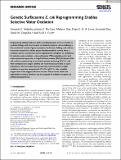| dc.contributor.author | Sedenho, Graziela C | |
| dc.contributor.author | Pacheco, Jéssica C | |
| dc.contributor.author | Gut, Melanie | |
| dc.contributor.author | Lima, Filipe CDA | |
| dc.contributor.author | Dey, Sunanda | |
| dc.contributor.author | Crespilho, Frank N | |
| dc.contributor.author | Furst, Ariel L | |
| dc.date.accessioned | 2025-11-03T15:41:01Z | |
| dc.date.available | 2025-11-03T15:41:01Z | |
| dc.date.issued | 2025-08-15 | |
| dc.identifier.uri | https://hdl.handle.net/1721.1/163493 | |
| dc.description.abstract | Programming catalytic behavior at the microbial genome level is a frontier in synthetic biology with direct impact on bioelectrocatalysis. A key challenge is the coordinated control of gene expression, localization, folding, and cofactor maturation required to achieve proper bioelectrocatalytic activity. Here, a synthetic operon in Escherichia coli is engineered to reprogram its surfaceome for selective water oxidation. Using orthogonal IPTG-inducible control and codon-optimized expression, a fungal bilirubin oxidase (BOD) displayed at the cell surface is produced by ice nucleation protein anchoring (BOD-E. coli). Post-overexpression copper catalytic site reconstitution provides an active holoenzyme. The developed engineered living material performs water oxidation at near-zero overpotential (27 mV at pH 9.1), with complete suppression of the oxygen reduction reaction. These results show how regenerable microbial platforms can be designed for selective catalysis and artificial photosynthesis. | en_US |
| dc.language.iso | en | |
| dc.publisher | Wiley | en_US |
| dc.relation.isversionof | https://doi.org/10.1002/adma.202508100 | en_US |
| dc.rights | Creative Commons Attribution | en_US |
| dc.rights.uri | https://creativecommons.org/licenses/by/4.0/ | en_US |
| dc.source | Wiley | en_US |
| dc.title | Genetic Surfaceome E. coli Reprogramming Enables Selective Water Oxidation | en_US |
| dc.type | Article | en_US |
| dc.identifier.citation | G. C. Sedenho, J. C. Pacheco, M. Gut, et al. “ Genetic Surfaceome E. coli Reprogramming Enables Selective Water Oxidation.” Adv. Mater. (2025): e08100. | en_US |
| dc.contributor.department | Massachusetts Institute of Technology. Department of Chemical Engineering | en_US |
| dc.relation.journal | Advanced Materials | en_US |
| dc.eprint.version | Final published version | en_US |
| dc.type.uri | http://purl.org/eprint/type/JournalArticle | en_US |
| eprint.status | http://purl.org/eprint/status/PeerReviewed | en_US |
| dc.date.updated | 2025-11-03T15:35:52Z | |
| dspace.orderedauthors | Sedenho, GC; Pacheco, JC; Gut, M; Lima, FCDA; Dey, S; Crespilho, FN; Furst, AL | en_US |
| dspace.date.submission | 2025-11-03T15:35:53Z | |
| mit.license | PUBLISHER_CC | |
| mit.metadata.status | Authority Work and Publication Information Needed | en_US |
